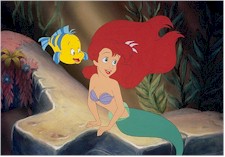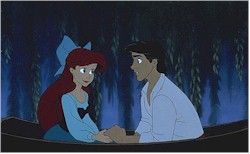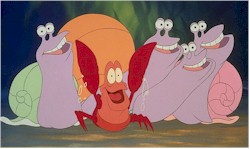|
| |
The Little Mermaid
Review by Carrie
Gorringe
Posted 14 November 1997
 |
|
Directed by John Musker and Ron Clements Starring
the voices of Rene Auberjonois,
Christopher Daniel Barnes, Jodi Benson, Pat Carroll,
Paddi Edwards, Buddy Hackett, Jason Marin,
Kenneth Mars, Ben Wright, and Samuel E. Wright
Screenplay by John Musker and Ron Clements,
adapted from the story by Hans Christian Andersen |
When Disney’s version of The Little Mermaid
was released in 1989, no one could have anticipated the film’s considerable success.
The trademark Disney touches were present – flawless visuals augmented by lots of
effects work, songs that were eminently hummable, colorful on-screen personalities
portrayed by talented off-screen personalities – so success should not have been that
surprising.  Its
success, however, did encourage Disney to work on the truly groundbreaking Beauty and
the Beast, released two years later (and was the first animated film to be nominated
for an Oscar in the Best Picture Category). That film set in motion a string of films
– Aladdin, The Lion King, The Hunchback of
Notre Dame and Hercules – that were
breathtaking in their technological complexity. Unfortunately, after 1994’s The
Lion King, there was a sense among audiences that technology and the urge to
one-upmanship had superceded the urge to tell a good story. Hunchback did only half
the business of The Lion King, and Hercules, for all of its merits, will
turn a very modest profit. In retrospect, The Little Mermaid was almost a throwback
to traditional Disney adaptations of classic fairy tales, such as Cinderella and Snow
White and the Seven Dwarfs; it was, and is, a film with quiet charms, as opposed to
the 10,000-watt brilliance of those that followed. Its
success, however, did encourage Disney to work on the truly groundbreaking Beauty and
the Beast, released two years later (and was the first animated film to be nominated
for an Oscar in the Best Picture Category). That film set in motion a string of films
– Aladdin, The Lion King, The Hunchback of
Notre Dame and Hercules – that were
breathtaking in their technological complexity. Unfortunately, after 1994’s The
Lion King, there was a sense among audiences that technology and the urge to
one-upmanship had superceded the urge to tell a good story. Hunchback did only half
the business of The Lion King, and Hercules, for all of its merits, will
turn a very modest profit. In retrospect, The Little Mermaid was almost a throwback
to traditional Disney adaptations of classic fairy tales, such as Cinderella and Snow
White and the Seven Dwarfs; it was, and is, a film with quiet charms, as opposed to
the 10,000-watt brilliance of those that followed.
In case memory fails you, the story, according to Disney, goes as follows: Ariel
(Benson), the youngest daughter of King Triton (Mars), is having those typical
sixteen-year-old growing pains. She feels that the water would seem bluer only if it
weren’t water at all, but land.  Yes, Ariel wants to be a human and walk on land, a desire
exacerbated by her sudden attraction to a Prince named Eric (Barnes). Against the better
judgment of her friend Flounder (Marin) and her father’s advisor, Sebastian the Crab
(S.E. Wright), Ariel sells her voice to the conniving sea witch named Ursula (Carroll),
for a three-day pass on land. If Ariel cannot make Eric fall in love with her, then she
will forfeit her soul to Ursula. To make matters worse, Ursula has robbed Ariel of the one
attribute that will mark her as the woman whom Eric loves: her siren-like voice. Since
this is not the only scheme that Ursula has nestled in her tentacles to ensure that the
deal ends in her favor, Sebastian, Flounder and a confused seagull named Scuttle (Hackett)
have their respective implements full trying to prevent Ursula from winning. Yes, Ariel wants to be a human and walk on land, a desire
exacerbated by her sudden attraction to a Prince named Eric (Barnes). Against the better
judgment of her friend Flounder (Marin) and her father’s advisor, Sebastian the Crab
(S.E. Wright), Ariel sells her voice to the conniving sea witch named Ursula (Carroll),
for a three-day pass on land. If Ariel cannot make Eric fall in love with her, then she
will forfeit her soul to Ursula. To make matters worse, Ursula has robbed Ariel of the one
attribute that will mark her as the woman whom Eric loves: her siren-like voice. Since
this is not the only scheme that Ursula has nestled in her tentacles to ensure that the
deal ends in her favor, Sebastian, Flounder and a confused seagull named Scuttle (Hackett)
have their respective implements full trying to prevent Ursula from winning.
To those accustomed to presumably grander objectives than finding love, The Little
Mermaid may seem a little too restrained in its pace and focus, but the film still
possesses a winning personality, thanks to the wonderful effects animation and the witty
musical compositions by Alan Menkin and the late Howard Ashman. To take just one
example, the "Under the Sea" sequence, set to the Oscar-winning song of the same
name, is the scintillating highlight of the film, full of rich tropical color and striking
movements, and underscores the considerable talents of Samuel E. Wright, who gave
Sebastian the charm to act as the moral and comic center of the piece. It takes a fair
degree of subversive moxie, admittedly, to make a crab use the words "sea" and
"fricassee" in one stanza; the act is not unlike asking a cow to confess its
fears of becoming beef stroganoff . Moreover, The Little Mermaid has benefited from
an extensive overhaul. The analog soundtrack has been replaced by four different versions,
including six-track digital sound. The entire film has been digitized to clean up some
dirt and smudges. Thanks to the fall cleaning, the lovely gem now sparkles even brighter,
and the adventures of the lovesick Ariel, the faithful Flounder, the wily Sebastian and
the evil Ursula are back on the screen for your entertainment – but only until
November 30th. To take just one
example, the "Under the Sea" sequence, set to the Oscar-winning song of the same
name, is the scintillating highlight of the film, full of rich tropical color and striking
movements, and underscores the considerable talents of Samuel E. Wright, who gave
Sebastian the charm to act as the moral and comic center of the piece. It takes a fair
degree of subversive moxie, admittedly, to make a crab use the words "sea" and
"fricassee" in one stanza; the act is not unlike asking a cow to confess its
fears of becoming beef stroganoff . Moreover, The Little Mermaid has benefited from
an extensive overhaul. The analog soundtrack has been replaced by four different versions,
including six-track digital sound. The entire film has been digitized to clean up some
dirt and smudges. Thanks to the fall cleaning, the lovely gem now sparkles even brighter,
and the adventures of the lovesick Ariel, the faithful Flounder, the wily Sebastian and
the evil Ursula are back on the screen for your entertainment – but only until
November 30th.
Contents | Features
| Reviews | News | Archives | Store
Copyright © 1999 by Nitrate Productions, Inc. All Rights
Reserved.
| |
|